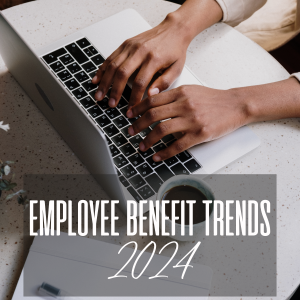
by admin | Feb 20, 2024 | Uncategorized
 NEW EMPLOYEE CLASSIFICATION RULE
NEW EMPLOYEE CLASSIFICATION RULE
In January, the Department of Labor (DOL) Wage and Hour Division introduced a rule that changes the way workers are classified under the Fair Labor Standards Act (FLSA). This Final Rule, effective March 11, 2024, offers a more comprehensive test to determine a worker’s status, potentially making it more challenging to classify workers as independent contractors for FLSA purposes. The rule is limited to FLSA wage and hour requirements and does not impact rules related to retirement or health and welfare benefits, which are typically governed by ERISA and the Internal Revenue Code. However, this change could lead to confusion and possibly claims for benefits. Under the federal FLSA, employees are entitled to minimum wage, overtime pay and other benefits. Independent contractors are not entitled to such benefits, but generally have more flexibility.
The rule establishes a test examining six key factors:
- Opportunity for profit or loss
- Investments by the worker and employer
- Permanence of the work relationship
- Degree of control
- Extent to which work is integral to the employer’s business
- Worker’s skill and initiative
These factors guide the assessment but are not exhaustive and none carry greater weight. This broadened definition under the FLSA could lead to more independent contractors being classified as employees for FLSA purposes. The DOL has provided Fact Sheet 13 to assist in the proper classification of workers.
The reclassification of workers as employees under the FLSA could have significant implications, particularly regarding employee benefits. For retirement benefits, this could mean an increase in eligible retirement plan participants, affecting employer obligations under plans like 401(k). Changes in FLSA classification may also influence health benefits, potentially increasing employers’ obligations under the employer mandate rules. This highlights the importance of careful planning and potential adjustments to existing plans and policies. Moreover, the new rule might trigger additional reporting requirements for employers, especially if they surpass certain thresholds.
EMPLOYER CONSIDERATIONS
Employers and HR professionals should understand and adapt to these changes, particularly in the gig economy, where many workers are currently classified as independent contractors. The rule’s emphasis on a totality-of-the-circumstances analysis for worker classification requires careful consideration of various economic factors. Given the potential for ongoing regulatory developments and challenges to the rule, it’s essential for employers to stay informed and prepare for possible impact on their operations and worker classifications.
GUIDANCE ON COVERAGE FOR CONTRACEPTIVES
The Affordable Care Act (ACA) Implementation FAQs Part 64, issued on January 22, 2024, provide guidance on preventive service coverage. Prepared by the Departments of Labor, Health and Human Services, and the Treasury, they aim to enhance understanding and compliance with the law and specify that non-grandfathered health plans must cover certain preventive services without cost-sharing. These services include recommended immunizations, preventive care for infants to adolescents, and additional preventive care for women. The guidelines allow plans to use reasonable medical management techniques to determine coverage limitations for services not explicitly detailed in recommendations.
The FAQs also detail the coverage of contraceptives and contraceptive care and advocate for comprehensive contraceptive care for adolescent and adult women, including a wide range of FDA-approved contraceptives and family planning practices. Plans and issuers are required to cover contraceptive services and products deemed medically appropriate by a patient’s provider. The guidelines also address the use of reasonable medical management techniques within contraception categories.
Despite these clarifications, the FAQs acknowledge ongoing barriers to accessing contraceptive coverage without cost-sharing. They outline examples of potentially unreasonable medical management techniques, such as excessive step therapy protocols, age-related restrictions, and burdensome administrative requirements in exceptions processes. The Departments emphasize the need for an expedient and transparent exceptions process to ensure coverage of medically necessary contraceptive services and products.
Finally, the FAQs introduce guidance on a therapeutic equivalence approach that plans and issuers may adopt. This approach, combined with an accessible and expedient exceptions process, aims to comply with the requirements regarding contraceptive coverage. This approach would support the coverage of contraceptive drugs and devices, facilitating better access to contraception without cost-sharing.
EMPLOYER CONSIDERATIONS
Individuals who have concerns about their plan’s or issuer’s compliance with the contraceptive coverage requirements may contact the Department of Labor (DOL) via its website or toll free at 1-866-444-3272.
CALIFORNIA SICK LEAVE FAQS
California’s Labor Commissioner updated its FAQs to reflect changes to the Healthy Workplaces Healthy Families Act (HWHFA) that are effective January 1, 2024. These amendments include an increase in the amount of leave employees can accumulate, carry over, or use. The updates also provide guidance on the accrual-based or frontloading methods for compliance and clarify that employers can ask for documentation to substantiate leave but cannot deny leave solely based on a lack of medical certification.
The new amendment impacts employees covered by collective bargaining agreements (CBAs) in specific ways. Beginning January 2024, these workers can use paid leave for similar reasons as others under the HWHFA, without the need to find a replacement worker. They are also protected under the law’s anti-retaliation provisions. However, the FAQs are unclear as to the way the changes align with CBAs’ arbitration provisions.
EMPLOYER CONSIDERATIONS
California employers must review and revise their paid sick and safe leave policies to comply with these changes and are required to display a poster in an area frequented by employees where it may be easily read during the workday.
The workplace posting must state:
- That an employee is entitled to accrue, request, and use paid sick days
- The amount of sick days provided for and the terms of use of paid sick days
- That retaliation or discrimination against an employee who requests paid sick days or uses paid sick days or both is prohibited
- That an employee has the right under this law to file a complaint with the Labor Commissioner against an employer who retaliates or discriminates against an employee
NEW YORK PROPOSED PAID FAMILY LEAVE EXPANSION
New York Governor Kathy Hochul has proposed an expansion of the state’s paid family leave law to include 40 hours of paid leave for prenatal medical appointments. This initiative, aimed at improving maternal and neonatal health, would make New York the first state to offer such coverage. The proposal is part of a broader effort to address rising maternal mortality rates, particularly among Black women, and to reduce unnecessary cesarean section births. New York already offers four months of paid leave; however those benefits are unavailable until four weeks before birth. The proposed changes reflect a growing recognition of the importance of prenatal care and the need to address disparities in maternal health outcomes.
EMPLOYER CONSIDERATIONS
Until this proposed expansion becomes law, employers in New York can ensure their familiarity with current law and required disclosures.
QUESTION OF THE MONTH
Q: Should veterans be excluded from the full time equivalent (FTE) count for determining if an employer is considered an applicable large employer (ALE)?
A: If the veteran employees have Tricare or receive health insurance through the Department of Veterans Affairs, they do not count for purposes of determining whether an employer is an applicable large employer.
Answers to the Question of the Week are provided by Kutak Rock LLP. Kutak Rock provides general compliance guidance through the UBA Compliance Help Desk, which does not constitute legal advice or create an attorney-client relationship. Please consult your legal advisor for specific legal advice.
| This information is general in nature and provided for educational purposes only. It is not intended to provide legal advice. You should not act on this information without consulting legal counsel or other knowledgeable advisors. |
| ©2023 United Benefit Advisors |

by admin | Feb 12, 2024 | Health Insurance
 What is Health Insurance and Why is it Important?
What is Health Insurance and Why is it Important?
Health insurance is a legal entitlement to payment or reimbursement for your health care costs, generally under a contract with a health insurance company. Health insurance provides important financial protection in case you have an accident or sickness. For example, health insurance may help to pay for doctors’ services, medications, hospital care, and special equipment when someone is sick or injured, often in exchange for a monthly premium. It may help cover a stay at a rehabilitation hospital or even a portion of home health care. Heath insurance can also keep a consumer’s costs down when they are not sick. For example, it can help pay for routine check-ups. Most health insurance also covers many preventive services at no cost, such as immunizations and cancer screening and counseling.
What is a Health Insurance Plan (also called a health plan or policy)?
A health insurance plan includes a package of covered health care items and services and sets how much it will pay for those items and services. In other words, a health plan will describe the types of health care items and services it will cover (help pay for), how much it will pay for those items and services (or groups of items and services), and for how long. Plans are often designed to last for a year at a time (known as a “plan year” or “policy year”). A health plan may be a benefit that an employer, union, or other group sponsor provides to employees or members to pay for their health care services.
What are Some Types of Health Care Coverage?
Health care coverage is often grouped into two general categories: private and public. The majority of people in the U.S. have private insurance, which they receive through their employer (which may include nongovernment employers or government employers at the federal, state or local level), buy directly from an insurance company, or buy through a Health Insurance Marketplace®.1 Some people have public health care coverage through government programs such as Medicare, Medicaid, or the Veteran’s Health Administration. Health care coverage can also be categorized by the scope of benefits it offers or how long the coverage lasts. Health insurance often includes a wide range of covered services, including emergency and nonemergency services as well mental health benefits. Some people have very limited insurance plans, such as plans with benefits for only specific conditions or diseases (included in the list of “excepted benefits” under the Affordable Care Act, such as vision-only plans or cancer plans).
As noted above, many health plans offer coverage for a year. However, some plans offer coverage for less than 12 months, including plans created to fill gaps in coverage. These plans are called short-term limited duration plans, and they often offer fewer benefits as compared to other health plans and lack some of the consumer protections available under other forms of coverage.
Self-Insured Employer Plans vs. Fully-Insured Plans
For consumers who receive health insurance through their employer, there are typically two different funding structures employers use to provide coverage:
- Some employers offer health care coverage to their employees through a self-insured plan. This is a type of health plan that is usually offered by larger companies where the employer collects contributions from employees via payroll deductions and takes on the responsibility of paying all related medical claims. These employers can contract with a thirdparty administrator (in some cases, a health insurance company acting as an administrator) for services such as enrollment, claims processing, and managing provider networks. Alternatively, these employers can self-administer the services. Self-insured plans are regulated by the federal government and are generally not subject to state insurance laws.
- A fully-insured employer plan is a health plan purchased by an employer from an insurance company. The insurance company, instead of the employer, takes on the responsibility of paying employees’ and dependents’ medical claims in exchange for a premium from the employer.
Originally posted on CMS.gov

by admin | Feb 6, 2024 | Hot Topics
 Critical illness insurance is known by many names: heart attack insurance, catastrophic illness insurance and sick insurance are just a few. No matter what it’s called, it’s designed to guard against the financial costs of a serious disease or condition.
Critical illness insurance is known by many names: heart attack insurance, catastrophic illness insurance and sick insurance are just a few. No matter what it’s called, it’s designed to guard against the financial costs of a serious disease or condition.
As the average life expectancy in the United States continues to increase, insurance brokers are finding ways to make sure Americans can afford the privilege of getting older. Critical illness insurance was developed in 1996, as people realized that surviving a heart attack or stroke could leave a patient with a mountain of medical bills.
Before you learn what critical illness insurance is, you should understand what it is not: medical insurance. This coverage is not meant to stand alone; it’s meant to be supplementary to other forms of coverage.
Critical illness insurance is simple – it provides a lump sum payment when you have a verified diagnosis of a covered illness. Critical illness insurance is offered as a voluntary benefit by some employers to supplement your regular medical coverage. You can use the critical illness benefit to pay for treatment, recovery or transportation costs associated with your illness, but unlike your existing health insurance, you’re not limited to medical costs. You can also use the money from a critical illness insurance policy to pay for a babysitter while you recover, utility bills, or however you see fit.
Common Critical Illnesses Covered
1. Cancer
2. Heart Attack
3. Stroke
4. Kidney Failure
5. Major Organ Transplant
Additional Illness and Conditions
Many policies also cover additional illnesses and conditions, such as Alzheimer’s Disease, Multiple Sclerosis, and severe burns.
Key Facts to Understand About Critical Illness Insurance:
- Critical illness insurance takes care of expenses that health insurance doesn’t normally cover and helps you meet your out-of-pocket costs
- Critical illness insurance only pays for certain conditions – you still need to rely on traditional health coverage for other illnesses
- You’ll receive just one large payment upon diagnosis, which may need to last for several years
- No networks, deductibles or co-payment
- Critical illness insurance does not cover pre-existing conditions
- Premiums become more expensive the older you are
- No restrictions on how you can use the funds, allowing you to choose what’s best for you
While it may not cover every disease, a critical illness insurance policy safeguards against many common and financially disruptive conditions. This coverage shields you from the impact of serious illnesses and unforeseen medical procedures by providing financial support for various needs—making up for lost wages, funding additional time off work, covering medical expenses, and even supporting travel for treatment. This support allows you to focus on the most important during this challenging time – getting better.

by admin | Feb 2, 2024 | Employee Benefits
 The challenges that influenced the benefits landscape in 2023 persist—perhaps even more so. Rising costs, due to inflation and increasing health care prices, will continue to present challenges this new year. But employers who understand the benefits landscape for 2024 can mold their approach for the upcoming year.
The challenges that influenced the benefits landscape in 2023 persist—perhaps even more so. Rising costs, due to inflation and increasing health care prices, will continue to present challenges this new year. But employers who understand the benefits landscape for 2024 can mold their approach for the upcoming year.
A new year means revisiting your existing benefits strategy and looking at the top benefit trends:
Financial Wellness Benefits
Employees worry and stress about their finances and are searching for financial wellness education and guidance. Nearly 80% of employees say a financial wellness benefit is an important part of a comprehensive benefits package. Some of the popular financial wellness benefits are:
- Retirement Plan Options with Matching Contributions
- Health Savings Accounts
- Flexible Spending Accounts
- Financial Planning Assistance
- Flexible Paydays
- Employee Discount Program
- Financial Reimbursements (Ie. student loan repayment plans, child-care support funds and professional development stipends)
Voluntary Benefits
You can please some of the people some of the time, but you can’t please all the people all the time – unless you embrace voluntary benefits, that is. Voluntary benefits are optional perks that are offered to employees at a discounted group rate which their employer has negotiated with providers. While employees still need to pay to use these benefits, the amount is usually far less than it would be without company subsidies.
Moving forward, we can expect to see more sophisticated customization tools that allow employees to choose the benefits that best align with their individual circumstances and priorities. Whether it’s affordable veterinary insurance for pet owners, subsidized pre-K childcare for parents, or student loan repayment programs, offering these types of policies can directly improve the quality of life for employees who choose to take advantage of them.
Enhanced Family Benefits
Employers are increasingly looking to expand their family-friendly benefits for employees to better support employees in their caregiving roles.
- Paid family leave is not guaranteed by law in the U.S. but it is a highly sought-after perk. A parental leave policy – one that considers both parents and accounts for adoption and fostering in addition to childbirth – can show your employees you care about supporting their home lives.
- Childcare assistance supports working parents facing rising costs of living. While some larger employers may offer on-site childcare, smaller businesses can show their commitment to working parents by helping to subsidize the cost of childcare through employer contributions or pre-tax deductions.
- Fertility assistance supports employees who are going through costly infertility treatments, surrogacy, and IVF.
With four generations represented in the workforce, the support offered by employers can look different to Baby Boomers caring for their parents than a Millennial or Gen Zer caring for their children.
Inclusive and Flexible Care
The diverse workforce of 2024 is prioritizing a better work-life balance. It’s important to develop a benefits package that recognizes a healthy environment for your employees.
- Mental health benefits are in demand since mental health is a crucial part of overall health. Offering an employee assistance program (EAP) is a great way to support workers in tough situations.
- Work flexibility includes not only remote or hybrid work options, but you can also consider flexible start and stop times, a four-day work week or unlimited PTO to attract top talent and increase retention.
Overall, your benefits offerings for 2024 should reflect your organization’s values. Remember, your company depends on being able to keep your employees happy, healthy, and productive. Benefits that show respect for employees and promote a strong, vibrant culture are worth the investment.

by admin | Jan 15, 2024 | Hot Topics
 As we begin to settle into 2024, many of us are thinking about New Year’s resolutions. The start of a New Year signals a time for change, reflection and a sense of ‘starting afresh’. This year, you can seize the new year’s spirit of renewal and make mental health your top priority!
As we begin to settle into 2024, many of us are thinking about New Year’s resolutions. The start of a New Year signals a time for change, reflection and a sense of ‘starting afresh’. This year, you can seize the new year’s spirit of renewal and make mental health your top priority!
A healthy mind will increase your self-esteem, attract positivity, and help you break those persistent bad habits. Don’t make the mistake of only writing ‘improve mental health’ on your New Year’s resolution list. To ensure success, you need to have a plan.
6 Tips to Improve Your Mental Health
Make a clear plan
Rather than attempting to overhaul several areas of your life, focus on one area at a time to maximize your chances of success. Checklists and timelines can help you track everything.
Set achievable health goals by making small, practical changes, like swapping out a meal or ingredient for a healthier option, rather than trying to quit all unhealthy foods at once.
Prioritize Sleep
Sleep is often the first thing to go. Poor sleep, especially over a period of a few weeks, leads to poor functioning: it impacts your immune system, ability to concentrate and your mood – all things that make you even more stressed out. It’s a vicious circle.
Prioritize “Me Time”
Taking some much needed “me time” isn’t selfish; taking care of yourself is one of the best mental wellness gifts you can receive. Do some yoga, take a walk, relax in the bathtub, or simply take some time to catch up on some reading. Your mental health will thank you for it.
Get Some Exercise
Exercise is an excellent way to destress. Focus on simply moving your body. Take the stairs or park your car further away from your destination to get some more steps in!
Enjoy Time with Friends and Family
Nurturing relationships with friends and family is crucial for a fulfilling life. Research shows that interacting with people we’re close to boosts our mood and makes us feel more connected. A strong support systems transforms challenges into manageable tasks and reassures you that you’re not alone.
Start a Gratitude Journal
Write down at least five things you’re grateful for and then reflect on why those things are important to you. It might be difficult at first, but the more you do it the easier it will become. You’ll find yourself feeling happier and more optimistic about life.
In a recent Forbes health survey, 50% of the respondents between the ages of 18 and 25 and 49% of those between 26 and 41 cited mental health as a top priority. Among respondents overall, 45% said improving their mental health was one of their top priorities.
Mental health is centered around the social and psychological aspects of our lives. Human beings are filled with complex thoughts and emotions — we are not preprogrammed to simply perform daily tasks. Our ability to think, feel, and navigate various experiences is tied to our mental state.
Good mental health gives us the resilience to process life’s challenges and helps us make wise decisions about the future. As you step into the new year, it’s essential to give your mental health the attention it deserves to ensure a balanced approach to your well-being.

 NEW EMPLOYEE CLASSIFICATION RULE
NEW EMPLOYEE CLASSIFICATION RULE



